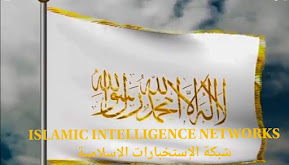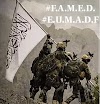NDLR : Apparently MI5 does not like this photo... Two war criminals ! What about this one ?
Anyone who saw the first of a new three-part BBC TWO series called "Clash of the Worlds" will have been given the impression that, prior to the arrival of Rev John Midgley Jennings in India in 1852, Indians had welcomed the British with "flowers and open arms" on account of pluralistic interpretations of their faiths.
Midgely Jennings spoilt it for all by attempting to proselytise Christianity in India, which sparked a violent "Wahhabi" Muslim reaction in the person of Sayyid Ahmad.
According to the author and co-presenter of the programme, Charles Allen, "Sayyid Ahmad's Wahhabism" created Islamic terrorism not only in the 19th century against the British, in the form of the 1857 Mutiny, but it also has a direct connection with acts of violence in the 21st century - including 9/11, 7/7 and plots to blow up aeroplanes at Heathrow in 2006 - through the "Wahhabi" Deobandi tradition. It's a fascinating story, but is it true?
Myth number one: Anglo-Indian relations were peaceful before Sayyid Ahmad
What the programme confidently omitted to mention was that, long before the arrival of Rev Midgley Jennings in 1852, the British East India Company had been fighting numerous devastating wars in India against Hindu and Muslim rulers including the Battle of Buxar, the Anglo-Maratha Wars (1777-1818), the Battle of Assaye, and the famous four Anglo-Mysore Wars that lasted over three decades.
These were hardly pluralistic or harmonious gestures of coexistence. Rather, they were the results of plain and simple brutal tension between the powers of domination and the dominated. For example, during the siege of Mysore in 1792 the British General, Lord Cornwallis, had forced the Sultan into a temporary treaty to hand over three million pounds and his young sons as hostages. Yet the BBC's so-called "experts" told us, in order to justify their "global-Wahhabi-threat" theory, that in India the "idea of worlds clashing would not have made sense to anyone".
Myth number two: Followers of Muhammad ibn Abd Al-Wahhab are all "anti-Western"
"Wahhabism" has become the convenient concept by which we can clump together all those aspects of Islam we wish to jettison from history. It is now the ultimate Room 101 for disposing of all that we find uncomfortable with Islam and wish to delete from Muslim consciousness. The problem is that history seldom allows the comprehensive destruction of records. If Muhamamd ibn Abd al-Wahhab's (1703-1792) version of Islam was so puritanically toxic that it could inspire an anti-British mutiny across the seas in India, why did it not have the same effect on people much closer to him?
For example, his strongest supporters and most ardent followers were the House of Saud. In December 1915, the British government had made the lands of the House of Saud a British protectorate and since then, by and large, the Saudi regime has maintained a cordial relationship with the British, the latest example being King Abdullah's state visit to Britain last week. There is certainly more to this picture than we have been led to remember. It was with a British stipend of £5000 a month and a steady supply of weapons that the founder of the Kingdom, Abd Al-Aziz ibn Saud, was able to defeat his opponents and galvanise his rule over Arabia.
Myth number three: Sayyid Ahmad was inspired by "Wahhabism"
Anger over the dismantling of historic Muslim monuments and relics in Saudi Arabia by some followers of Muhammad Ibn Abd al-Wahhab had given rise to the coining of the term "Wahhabi" in India to describe anything undesirable. Being so, it aptly served those British academics of an imperialist mindset who wanted to undermine Sayyid Ahmad's freedom fighter credentials to label him a "Wahhabi". The famous historian W.W. Hunter wrote in his Our Indian Musalmans (1871) that Sayyid Ahmad was a follower of Muhammad ibn abd al-Wahhab and that he was expelled from the Holy city of Makkah during the Hajj.
These allegations have since been proven to be baseless by a number of researchers. Sayyid Ahmad had no contact whatsoever with ibn Abd Al-Wahhab. In fact, at the time of his pilgrimage to Makkah in 1822, there were no "Wahhabi" preachers in those areas for in 1818 the Ottomans had marched on their stronghold in Dariya and killed many members of the Abd al-Wahhab family. The chief of the area, Abdullah the son of Muhammad Ibn Abd Al-Wahhab, was deported to Constantinople and executed. In 1822, the Hijaz area of the Arabian peninsular was devoid of any "Wahhabi" influence.
More importantly, Sayyid Ahmad had launched his campaign for jihad several years before embarking on the pilgrimage. It was Shah Abd Al-Aziz, son of Shah Wali Ullah Dehlawi, who had advised Sayyid Ahmad to go on a country-wide tour in 1818 to raise awareness for his cause. That advice had absolutely nothing to do with Muhammad ibn Abd al-Wahhab.
Myth number four: Deobandis are all inspired by "Wahhabi" Islam
Charles Allen suggested in the programme that the seminary in Deoband was established by students under the "Wahhabi" influence brought from Arabia to India by Sayyid Ahmad in 1922. If there is one feature through which interpretive traditions in Islam can be identified, it is through their adopted schools of jurisprudence. Schools of jurisprudence in Islam determine the framework parameters within which any given interpreter may function. Principally, in Sunni Islam, there are four major schools of jurisprudence, known as the Hanafi, Shafi, Maliki and Hanbali schools.
These schools are distinguished from one another through their differing approaches to a vast number of issues (though not including basic tenets of creed), which range from methods of praying the daily five prayers to matters of divorce and complex government and financial issues. Rulings of one school are not automatically applicable for a follower of another school unless it is proven to satisfy the interpretive criteria of that specific school. In practice, followers of a particular school will only seek and follow rulings from within their school. The Deobandis are strict followers of the Hanafi school and Muhammad ibn Abd Al-Wahhab was a follower of the Hanbali school.
If Deoband Madrasa (seminary) was an institution inspired principally by the mythical "Wahhabism" that requires its follows to denounce all others in an accept-Islam-or-die cult, then it is hard to understand why such an institution would produce the likes of the late Moulana Husayn Ahmad Madani (d.1957), who was Shaikh al-Hadith of Darul Ulum Deoband (the highest professorial position in the seminary) and who declared, very forcefully, in the 1930s:
"The view that Islam is an inflexible religion is beyond my comprehension. To the extent that I can understand its laws, [Islam] can live together with non-Muslims in the same country; it can be at peace with them; it can enter into treaties with them; as well as into commercial transactions, partnerships, tenancy, the exchange of gifts, loans, trusts, etc. Muslims can interact with them, participate in matters of joy and grief, and dine with them..." (Madani, Muttahida Qawmiyyat, p.51).
Another historical fact that demolishes the "Deobandi-Wahhabism" myth of its followers being on the constant prowl to grab swathes of land and colonise them with puritanical regimes, is that Moulana Madani and his fellow Deobandi followers, and including a vast number of other ulama (religious scholars), opposed the creation of the state of Pakistan. Large numbers of Deobandi scholars demanded to live in an undivided, free India.
If these facts are also part of the legacy of Sayyid Ahmad Shahid and the founders of the Deobandi school, which of course they are, then we certainly need to take a more informed look at recent history before trying to join isolated dots from pages in paperbacks and fictional accounts masquerading as historical narrative.
Conclusion
The real question is why are academics, orientalists, policy makers and TV producers fanning the flames of war with 18th and 19th century trickery? Why is the role of the CIA in the Afghan-Soviet war and the role of the Neocon policy makers in the current wars not acknowledged in this flood of rhetoric we hear on Wahhabism and Deobandism? The answer, I suspect, is that somehow they hope to not only win these wars with a decisive victory but also to dispose along with them all those aspects of Islam they find difficult to accept.
By truncating chunks of history and bundling them together with unpleasant realities of the day, it may allow for some Western designed "reformationist" theories to be superficially buttressed and problematic inconveniences to be disposed of in a "Grand Room 101" of history.
Unfortunately however, history has a habit of remaining persistently uncooperative with those who try to exploit it.





0 Comments